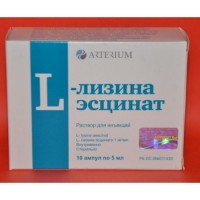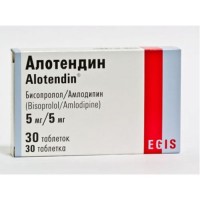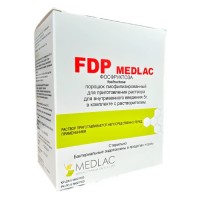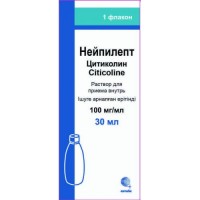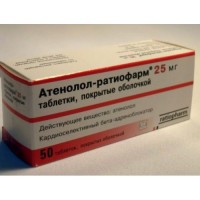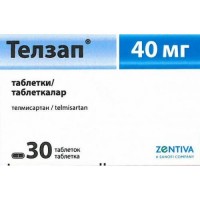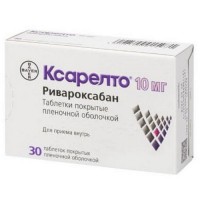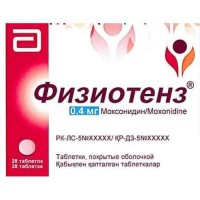Prestilol® (Bisoprolol / Perindopril) 10 mg/10 mg, 30 film-coated tablets
- $40.00
Out Of Stock
Sku:
c61c0c379b56
Brand:
Servier (France)
The instruction for medical use of Prestilol Torgovoye medicine a name Prestilol Mezhdunarodnoye the unlicensed name Is not present the Dosage form Prestilol 5 mg / 5 mg, a tablet, film coated Prestilol of 5 mg / 10 mg, a tablet, film coated Prestilol of 10 mg / 5 mg, a tablet, film coated Prestilol of 10 mg / 10 mg, a tablet, film coated Structure One tablet contains active agents: One tablet, film coated contains 5 mg of a bisoprolol of the fumarat (there correspond 4.24 mg of a bisoprolol) and 5 mg of a perindopril of arginine (there correspond 3.395 mg of a perindopril). One tablet, film coated contains 5 mg of a bisoprolol of the fumarat (there correspond 4.24 mg of a bisoprolol) and 10 mg of a perindopril of arginine (there correspond 6.790 mg of a perindopril). One tablet, film coated contains 10 mg of a bisoprolol of the fumarat (there correspond 8.49 mg of a bisoprolol) and 5 mg of a perindopril of arginine (there correspond 3.395 mg of a perindopril). One tablet, film coated 10 mg of a bisoprolol of the fumarat (there correspond 8.49 mg of a bisoprolol) and 10 mg of a perindopril of arginine (there correspond 6.790 mg of a perindopril). excipients (first layer): cellulose microcrystalline pH 102, calcium the carbonate containing starch (E170), corn starch prezhelatinizirovanny, sodium of a kroskarmelloz (E468), silicon dioxide colloidal anhydrous (E551), magnesium stearate (E572). excipients (second layer): cellulose microcrystalline pH 102, calcium the carbonate containing starch (E170), corn starch prezhelatinizirovanny of sodium of starch glikolit type A (E468), silicon dioxide colloidal anhydrous, magnesium stearate. structure of a film cover of Sepifilm ****: glycerin (E422), gipromelloz (E464), macrogoal 6000, magnesium stearate (E572), titan dioxide (E171), ferrous oxide yellow (E172), ferrous oxide red (E 172). Description Prestilol of 5 mg / 5 mg: tablets of oblong shape, film coated pinkish-beige color, two-layer, divisible on two parts, with an engraving 5/5 on one party of a tablet andon other party (for a dosage of 5/5 mg). Prestilol of 5 mg / 10 mg: tablets of oblong shape, film coated pinkish-beige color, two-layer, divisible on two parts, with an engraving 5/10 on one party of a tablet andon other party (for a dosage of 5/10 mg). Prestilol of 10 mg / 5 mg: tablets of round shape, film coated pinkish-beige color, two-layer, with an engraving 10/5 on one party of a tablet andon other party (for a dosage of 10/5 mg). Prestilol of 10 mg / 10 mg: tablets of oblong shape, film coated pinkish-beige color, two-layer, with an engraving 10/10 on one party of a tablet andon other party (for a dosage of 10/10 mg). Pharmacotherapeutic group Cardiovascular sitema. The means operating on renin an angiotenzinovy system. APF inhibitors in a combination with other drugs. Perindopril and bisoprolol. ATH code: C09BX02 the Pharmacological Pharmacokinetics Speed properties and extent of absorption of a bisoprolol and a perindopril after administration of drug Prestilol has no essential differences respectively from speed and extent of absorption of a bisoprolol and a perindopril after their reception separately in the form of monotherapy. Bisoprolol connected with bisoprololy Absorption almost completely (& gt, 90%) is absorbed in digestive tract, and in connection with low metabolism of the first passing through a liver (about 10%) its bioavailability after oral introduction is about 90%. Distribution the Volume of distribution makes 3.5 l/kg. Linking of a bisoprolol with blood proteins makes about 30%. Biotransformation and removal Removal of a bisoprolol from an organism occurs in two ways. 50% are metabolized in a liver to inactive metabolites which then are removed through kidneys. Other 50% are removed through kidneys in not changed look. The general clearance is about 15 l/h. As a result plasma elimination half-life is equal to 10-12 hours, effect of drug after introduction continues within 24 hours once a day. Special categories of patients Bisoprolol has linear pharmacokinetics, with age it does not change. As kidneys and a liver equally participate in drug removal, dose adjustment is not required to patients with an abnormal liver function or a renal failure. The pharmacokinetics at patients with chronic heart failure and an abnormal liver function or kidneys is not studied. At patients with chronic heart failure (stage of III in NYHA) the levels of a bisoprolol in plasma are higher, and elimination half-life longer, than at healthy volunteers. At a daily dose of 10 mg the maximum concentration in plasma in an equilibrium state makes 64 ± 21 ng/ml, and elimination half-life 17 ± 5 hours. Connected with perindoprily Absorption At oral administration perindoprit quickly it is soaked up, the maximum concentration is reached within 1 hour. Elimination half-life of a perindopril makes 1 hour of plasma. Distribution the Volume of distribution of the untied perindoprilat makes about 0.2 l/kg. Linking of the perindoprilat with proteins of plasma makes 20%, binding generally happens to APF, but depends on concentration of drug. Biotransformation Perindopril is pro-medicine. 27% of the accepted dose of a perindopril come to a blood stream in the form of an active metabolite of the perindoprilat. Except the active perindoprilat in an organism five more inactive metabolites are formed. The maximum concentration of the perindoprilat in plasma is reached in 3–4 hours after administration of drug. Meal reduces transformation of a perindopril in perindoprilat and consequently, and its bioavailability therefore perindoprit arginine it is recommended to accept once a day, orally, in the morning before a breakfast. Removal Perindoprilat is allocated with urine, final elimination half-life of its free fraction makes about 17 hours that allows to reach steady state in 4 days. Linearity It was shown that communication between a dose of a perindopril and its exposure in plasma is linear. Special categories of patients Removal of the perindoprilat slows down at elderly patients and also at patients with a heart or renal failure. Patients with a renal failure are recommended to carry out selection of a dose taking into account extent of disturbance of renal function (clearance of creatinine). At dialysis the clearance of a perindopril is 70 ml/min. The kinetics of a perindopril changes at patients with cirrhosis: the hepatic clearance of an initial molecule slows down twice. However the number of the formed perindoprilat does not decrease therefore selection of a dosage is not required (see the sections Route of Administration and Doses and Special Instructions). A pharmacodynamics the action Mechanism Bisoprolol Connected with bisoprololy is the high-selection blocker of beta1-adrenoceptors which is not possessing the stimulating and significant membrane stabilizing action. It shows low affinity to beta2-receptors of unstriated muscles of bronchial tubes and vessels and also to the beta2-receptors tied with metabolism regulation. Thus, in general, it is not necessary to expect influence on resistance of the airways and metabolic effects mediated by beta2-receptors from a bisoprolol. Its selectivity to beta1-receptors is noted also behind borders of range therapeutic the dosed Perindopril Connected with perindoprily is an inhibitor of enzyme which turns angiotensin I into angiotensin II (APF). Reformative enzyme or a kinase is an ekzopeptidaza which allows to turn angiotensin I into vasoconstrictive angiotensin II and also causes disintegration of vasodilating bradykinin to inactive heptapeptide. The inhibition of APF leads to decrease in angiotensin II in plasma that leads to increase in activity of renin in plasma (at the expense of inhibition of negative feedback of release of renin) and to decrease in discharge of Aldosteronum. As APF inactivates bradykinin, APF inhibition also leads to increase in activity of the circulating and local kallikrein-kinin system (and also to activization of a system of prostaglandin). It is possible that this mechanism promotes approach of hypotensive effect of APF inhibitors and partially causes some of side effects (for example, cough). Perindopril acts through the active metabolite perindoprilat. Other metabolites did not show in vitro of ability to inhibit action of APF. The Pharmakodinamichesky Connected properties with bisoprololy Bisoprolol has no significant negative inotropic effect. The maximum expressiveness of effects of a bisoprolol is reached in 3-4 hours after introduction. As elimination half-life of a bisoprolol makes 10-12 hours, he acts within 24 hours. The maximum action of a bisoprolol concerning a lowering of arterial pressure is usually reached in 2 weeks. At single introduction to patients with a coronary artery disease without chronic heart failure, bisoprolol reduces ChSS and stroke output and, therefore, warm emission and consumption of oxygen. At long introduction originally increased peripheric resistance decreases. Assume that the mechanism which is the cornerstone of antihypertensive action of beta-blockers is plasma renin decrease of the activity. Bisoprolol reduces the simpatiko-adrenergic answer, blocking warm beta adrenoceptors. It leads to decrease in ChSS and contractility, causing oxygen consumption reduction by a myocardium that is desirable effect in case of the stenocardia connected with a basic disease a coronary artery disease. Perindopril connected with perindoprily Hypertensia acts in arterial hypertension of any degree: weak, average and heavy, reduces systolic and diastolic arterial blood pressure both in a dorsal decubitus, and in a standing position. Perindopril reduces resistance of peripheral vessels that leads to a lowering of arterial pressure. As a result, the peripheral blood stream increases, without influencing heart rate. As a rule, the renal blood stream increases while the glomerular filtration rate (GFR) usually remains without changes. Warm insufficiency (Prestilol of 5 mg / 5 mg and Prestilol of 10 mg / 5 mg) Perindopril reduces cardiac performance, reducing preloading and an afterload Clinical performance and safety Connected with bisoprololy included In the research CIBIS II in total 2647 patients. 83% (n = 2202) had class III on classification of NYHA (New York cardiological association), and 17% (n = 445) — class IV on classification of NYHA. Patients had stable systolic heart failure with clinical manifestations (fraction of emission & lt, 35% according to an echocardiography). The general mortality decreased from 17.3% to 11.8% (relative decrease in 34%). Reduction of quantity of cases of sudden death (3.6% in comparison with 6.3%, relative decrease in 44%) and reduction of quantity of the episodes of heart failure which demanded hospitalization was observed (12% in comparison with 17.6%, relative decrease in 36%). At last, significant improvement of the functional status according to classification of NYHA is shown. In an initiation of treatment and during selection of a dose of a bisoprolol, hospitalization owing to bradycardia (0.53%), arterial hypotension (0.23%) and a sharp decompensation (4.97%) were observed, but they were done not more often than in group of placebo (0%, 0.3% and 6.74%). The quantity of fatal and disabling strokes for the entire period of a research was 20 in group of a bisoprolol and 15 in group of placebo. In the research CIBIS III studied 1010 patients aged ≥ 65 years with chronic heart failure easy or moderate severity (class II or III on NYHA) and fraction of emission of a left ventricle of ≤35% which prior to a research did not receive treatment by APF inhibitors, beta-blockers or blockers of receptors of angiotensin. Patients received treatment by a combination of a bisoprolol and enalapril within 6–24 months after initial 6-month treatment or bisoprololy, or enalapril. The tendency to higher frequency of cases of deterioration in chronic heart failure in group of patients at whom as initial 6-month treatment used bisoprolol is noted. In the analysis in sample of the patients who received treatment under the protocol (sample of PP) not the smaller efficiency of the scheme of treatment with initial use of a bisoprolol in comparison with the scheme with initial use of enalapril was not proved though two strategy of an initiation of treatment of chronic heart failure showed the similar frequency of achievement of primary combined final point including cases of death and hospitalization by the end of a research (32.4% in group with initial use of a bisoprolol in comparison with 33.1% in group with initial use of enalapril, sample of PP). The research showed what bisoprolol can also be applied at elderly patients with chronic heart failure easy or moderate severity. Perindopril connected with perindoprily Hypertensia acts in arterial hypertension of any degree: weak, average and heavy, reduces systolic and diastolic arterial blood pressure both in a dorsal decubitus, and in a standing position. Perindopril reduces resistance of peripheral vessels that leads to a lowering of arterial pressure. As a result, the peripheral blood stream increases, without influencing heart rate. As a rule, the renal blood stream increases while SKF usually remains without changes. The maximum antihypertensive activity is reached in 4–6 hours after reception of a single dose and remains within not less than 24 hours: the effect at the minimum concentration of drug is about 87-100% of effect at the maximum concentration. The lowering of arterial pressure comes quickly. At the patients susceptible to treatment, normalization of arterial blood pressure happens within a month and remains without emergence of a tachyphylaxis. The termination of treatment is not followed by development of ricochet effect. Perindopril reduces a hypertrophy of a left ventricle. It is confirmed that at the person perindoprit has vasodilating effect. He improves elasticity of large arteries and reduces the relation of thickness of a mussel to a vessel gleam. The APF inhibitor combination with thiazide diuretic results in additive synergism. The APF inhibitor combination with thiazide drug also reduces risk of the hypopotassemia arising at intake of diuretics. Heart failure (Prestilol5 of mg / 5 mg and Prestilol of 10 mg / 5 mg) Researches of patients with heart failure showed: - decrease the filling pressure of the left and pavy ventricles, - decrease in the general resistance of peripheral vessels, - increase in minute warm emission and improvement of cardiac index. In comparative researches the first reception of 2.5 mg of a perindopril of arginine by patients with heart failure of easy or average degree did not cause a significant lowering of arterial pressure in comparison with placebo Patients with a stable coronary artery disease the Research EUROPA continued 4 years, it was multicenter, international, randomized, double blind clinical trial with placebo control. Twelve thousand two hundred eighteen (12,218) patients are more senior than 18 years underwent randomization for reception of a perindopril rubs - butylamine of 8 mg (that is equivalent to 10 mg of a perindopril of arginine) (n = 6110) or placebo (n = 6108). Population of a research had an established coronary artery disease without clinical signs of heart failure. In general, 90% of patients in the past had a myocardial infarction and/or coronary revascularization. Most of patients received the studied drug in addition to traditionally accepted therapy, including inhibitors of thrombocytes, hypolipidemic drugs and beta-blockers. The compound criterion including cardiovascular death, not fatal myocardial infarction and/or cardiac arrest with successful resuscitation was the main criterion of efficiency. Treatment of a perindopril rubs - butylamine of 8 mg (that is equivalent to 10 mg of a perindopril of arginine) at reception led to absolute significant decrease in primary final point by 1.9% (decrease in relative risk of N
of 20%, D of 95%
) once a day – r & lt, 0.001). At the patients who had a myocardial infarction and/or revascularization in the anamnesis the absolute decrease by 2.2% that corresponds to the decrease in relative risk (DRR) for 22.4% (D of 95%
– p & lt, 0.001) on primary final point in comparison with placebo was reached. In the analysis of the subgroup of the patients who received treatment by beta-blockers in the research EUROPA, set in the posteriori analysis it is shown that addition of a perindopril to beta-blockers (n = 3789) led to significant absolute decrease by 2.2% (decrease in relative risk by 24%, 95% of DI
) of value of the compound criterion including cardiovascular death, not fatal myocardial infarction and/or cardiac arrest with successful resuscitation in comparison with treatment by beta-blockers without perindopril (n = 3745). Data of clinical trials on double blockade renin-angiotensin-aldosteronovoy of system (RAAS) In two large randomized controlled studies (the research ONTARGET (the continuing research of a telmisartan as monotherapy and in a combination with ramiprily with a complex final point) and the research VA NEPHRON-D (a nephropathy research in diabetes at patients of Management for veterans)) studied use of a combination of APF inhibitor with a blocker of receptors of angiotensin II. The research ONTARGET represented the research conducted at patients with the anamnesis of cardiovascular or cerebrovascular diseases or the diabetes 2 types which was followed by signs of ischemic defeat of bodies. The research VA NEPHRON-D is the research conducted at patients with diabetes 2 types and a diabetic nephropathy. In these researches the significant positive effect on renal and/or cardiovascular outcomes and mortality was not revealed, but at the same time the increased risk of a hyperpotassemia, intense injury of kidneys and/or hypotensions in comparison with monotherapy was observed. Considering their similar pharmakodinamichesky properties, these results are also applicable to other APF inhibitors and blockers of receptors of angiotensin II. For this reason APF inhibitors and blockers of receptors of angiotensin II should not be used in a combination at patients with a diabetic nephropathy. The research ALTITUDE (a research of an aliskiren in diabetes 2 types with use of cardiovascular and renal final points) represented a research which purpose was to estimate advantage of addition of an aliskiren to standard therapy by APF inhibitor and blockers of receptors of angiotensin II at patients with diabetes 2 types and a chronic disease of kidneys and/or a cardiovascular disease. The research was stopped ahead of schedule in view of the increased risk of undesirable outcomes. Death because of cardiovascular diseases and strokes was in a quantitative sense observed more often in group of an aliskiren in comparison with group of placebo, and messages about the undesirable phenomena and the serious undesirable phenomena which are of interest (hyperpotassemia, hypotension and a renal failure) arrived more often concerning group of an aliskiren in comparison with group of placebo. Children and teenagers Data on Prestilol's use among children and teenagers are absent. The European agency on medicines approved refusal of obligations for Prestilol regarding use in all subgroups of pediatric population for treatment of arterial hypertension, stable coronary heart disease and chronic heart failure (information on use for children and teenagers see in the section Route of Administration and Doses). Preclinical data on safety Connected with bisoprololy the Data obtained during preclinical standard pharmacological trials of safety, researches of toxicity of repeated doses of genotoxicity and carcinogenicity indicate lack of special danger of a bisoprolol to the person. In researches of reproductive toxicity bisoprolol did not affect fertility or other general indicators of reproduction of animals. As well as other beta-blockers, bisoprolol in high doses made toxic impact on mother's organism (decrease in meal and decrease in body weight) and on an embryo/fruit (higher frequency of resorptions, degrowth of a body at posterity at the birth, delay of physical development), but had no teratogenic effect. Connected with perindoprily In researches of chronic toxicity at oral administration (on rats and monkeys), body receptor are kidneys, disturbances have reversible character. The mutagenicity in the researches in vitro and in Vivo was not noted. Researches of reproductive toxicology (on rats, mice, rabbits and monkeys) did not reveal signs of embriotoxity or teratogenecity. However, it was shown that APF inhibitors as a class make undesirable impact on late fetation that leads to death of a fruit and congenital disturbances at rodents and rabbits: damages of kidneys and growth perinatal and postnatal mortality were observed. The fertility was not broken neither at males, nor at females of rats. The carcinogenicity in researches of long reception on rats and mice was not noted. Risk assessment for the environment Prestilol contains the known active ingredients: bisoprolol also perindoprit. Prestilol appoint as direct replacement of the therapy made with use of a bisoprolol and perindopril in the form of separate drugs therefore impact on the environment does not increase. Indications - for replacement at treatment of arterial hypertension, and/or stable coronary artery disease (at patients with a myocardial infarction and/or revascularization in the anamnesis), and/or stable chronic heart failure with decrease in systolic function of a left ventricle at adult patients at whom appropriate control of a disease is reached by means of the simultaneous use of a bisoprolol and a perindopril entered in the same doses (for a dose of 5 mg / 5 mg and 10 mg / 5 mg) - for replacement at treatment of arterial hypertension, and/or stable coronary artery disease (at patients with a myocardial infarction and/or revascularization in the anamnesis), at adult patients, at whom appropriate control of a disease is reached by means of the simultaneous use of a bisoprolol and a perindopril entered in the same doses (for a dose of 5 mg / 10 mg and 10 mg / 10 mg), the Way of reception Prestilol it is necessary to accept the Route of administration and doses in the form of a single dose once a day, in the morning before a breakfast. The dosing mode the Usual mode of dosing — one tablet once a day. Transition to the fixed combination can be carried out after achievement of a stable condition of the patient for at least 4 weeks against the background of use of a bisoprolol and a perindopril in the same doses. The fixed combination is not suitable for initial therapy. Patients at whom the stable state against the background of use of a bisoprolol of 2.5 mg and a perindopril of 2.5 mg is reached should accept on half-tablets 5 mg / 5 mg, once a day. At emergence of need for change of a dose it is necessary to execute selection of a dose with use of separate components. Special categories of patients the Renal failure (see. the sections Special Instructions and Pharmacokinetics) the Recommended Prestilol's dose of 5 mg / 5 mg for patients with a renal failure has to be selected depending on clearance of creatinine, according to table 1 which is given below. Table 1. Correction of a dose in a renal failure Clearance of creatinine (KlKR), the daily dose of KlKR Recommended to ml/min. ≥ 60 One tablet Prestilola of 5 mg / 5 mg 30 & lt, KlKR<, 60 Poltabletki Prestilola of 5 mg / 5 mg of KlKR<, 30 does not approach. Individual selection of a dose with use of separate components in the form of the monodrugs Abnormal liver function is recommended (see the sections Special Instructions and Pharmacokinetics) with an abnormal liver function of correction of a dose it is not required to Patients. Elderly patients Prestilol's Dose should be chosen according to function of kidneys. Children and teenagers Safety and Prestilol's efficiency at children and teenagers are not established. Data on use in this group of patients are absent. Therefore prescribing of drug is not recommended to children and teenagers. Side effects by the Most widespread undesirable reactions on bisoprolol are a headache, dizziness, weighting of heart failure, arterial hypotension, cold extremities, nausea, vomiting, an abdominal pain, diarrhea, a constipation, an asthenia and fatigue. The most widespread undesirable reactions revealed in clinical trials at reception of a perindopril are the headache, dizziness, vertigo, paresthesia, disorders of vision, tinnitus, arterial hypotension, cough, an asthma, nausea, vomiting, an abdominal pain, diarrhea, a constipation, a dysgeusia, dyspepsia, rash, an itching, kramp and an asthenia. The most often met side reactions at use of an ivabradin (changes a svetovospriyatiya (phosphene) and bradycardia) have dose-dependent character and are connected with pharmacological effect of drug. Very often (& gt, 1/10), it is frequent (& gt, 1/100, & lt, 1/10), infrequently (& gt, 1/1000, & lt, 1/100), is rare (& gt, 1/10000, & lt, 1/1000), is very rare (& gt, 1/10000), frequency is not established (on the basis of the available data it is not possible to carry out the development frequency assessment). MedDRA the Class of systems of bodies Undesirable effects Frequency Bisoprolol Perindopril Infektsionnye and parasitic diseases Rhinitis Rare Very rare Disturbances from the haematogenic and lymphatic system the Eosinophilia - Infrequently * the Agranulocytosis (see the section Special Instructions) - Very rare the Pancytopenia - Very rare the Leukopenia - Very rare the Neutropenia (see the section (see the section Special Instructions) - Very rare Thrombocytopenia (see the section (see the section Special Instructions) - Very rare Hemolytic anemia at patients with congenital insufficiency glyukozo-6-fosfatdegidrogenazy - Very rare Disturbances of metabolism and food the Hypoglycemia (see sections (see the section Special Instructions and Medicinal Interactions) - Infrequently * the Hyperpotassemia reversible at the treatment termination - Infrequently * the Hyponatremia - Infrequently * Mental disorders Change of mood - Infrequently the Sleep disorder Infrequently Infrequently the Depression Infrequently - Night dreadful dreams, hallucinations Rare - Confusion of consciousness - Very rare Disturbances from nervous system the Headache ** Is often frequent Dizziness ** Often Often Vertigo - Often the Dysgeusia - Often Paresthesia - Often Drowsiness - Infrequently * to the Syncope Rare Infrequently * Disturbances from organs of sight the Disorder of vision - frequent Reduction of a slezootdeleniye (it is necessary to consider if the patient carries lenses) Rare - Conjunctivitis Very rare - Disturbances from organs of hearing and a labyrinth Tinnitus - Often the Hearing disorder Rare - Disturbances from heart Heartbeat - Infrequently * Tachycardia - Infrequently * Bradycardia Very often - Weighting of heart failure Is frequent - Disturbances of atrioventricular conductivity Infrequently - Arrhythmia - Very rare Stenocardia - Very rare the Myocardial infarction which perhaps arose again against the background of the profound arterial hypotension at patients of group of high risk (see the section (see. the section Special Instructions) - Very rare Vascular disorders Hypotension (and the effects connected with hypotension) Numbness or a cold snap of extremities Often - Orthostatic hypotension Infrequently - the Vasculitis Is often frequent - Infrequently * the Stroke which perhaps arose again against the background of the profound arterial hypotension at patients of group of high risk (see the section (see the section Special Instructions) - Very rare Disturbances from the respiratory system, bodies of a thorax and mediastinum Cough -
to Develop Often
of 20%, D of 95%
) once a day – r & lt, 0.001). At the patients who had a myocardial infarction and/or revascularization in the anamnesis the absolute decrease by 2.2% that corresponds to the decrease in relative risk (DRR) for 22.4% (D of 95%
– p & lt, 0.001) on primary final point in comparison with placebo was reached. In the analysis of the subgroup of the patients who received treatment by beta-blockers in the research EUROPA, set in the posteriori analysis it is shown that addition of a perindopril to beta-blockers (n = 3789) led to significant absolute decrease by 2.2% (decrease in relative risk by 24%, 95% of DI
) of value of the compound criterion including cardiovascular death, not fatal myocardial infarction and/or cardiac arrest with successful resuscitation in comparison with treatment by beta-blockers without perindopril (n = 3745). Data of clinical trials on double blockade renin-angiotensin-aldosteronovoy of system (RAAS) In two large randomized controlled studies (the research ONTARGET (the continuing research of a telmisartan as monotherapy and in a combination with ramiprily with a complex final point) and the research VA NEPHRON-D (a nephropathy research in diabetes at patients of Management for veterans)) studied use of a combination of APF inhibitor with a blocker of receptors of angiotensin II. The research ONTARGET represented the research conducted at patients with the anamnesis of cardiovascular or cerebrovascular diseases or the diabetes 2 types which was followed by signs of ischemic defeat of bodies. The research VA NEPHRON-D is the research conducted at patients with diabetes 2 types and a diabetic nephropathy. In these researches the significant positive effect on renal and/or cardiovascular outcomes and mortality was not revealed, but at the same time the increased risk of a hyperpotassemia, intense injury of kidneys and/or hypotensions in comparison with monotherapy was observed. Considering their similar pharmakodinamichesky properties, these results are also applicable to other APF inhibitors and blockers of receptors of angiotensin II. For this reason APF inhibitors and blockers of receptors of angiotensin II should not be used in a combination at patients with a diabetic nephropathy. The research ALTITUDE (a research of an aliskiren in diabetes 2 types with use of cardiovascular and renal final points) represented a research which purpose was to estimate advantage of addition of an aliskiren to standard therapy by APF inhibitor and blockers of receptors of angiotensin II at patients with diabetes 2 types and a chronic disease of kidneys and/or a cardiovascular disease. The research was stopped ahead of schedule in view of the increased risk of undesirable outcomes. Death because of cardiovascular diseases and strokes was in a quantitative sense observed more often in group of an aliskiren in comparison with group of placebo, and messages about the undesirable phenomena and the serious undesirable phenomena which are of interest (hyperpotassemia, hypotension and a renal failure) arrived more often concerning group of an aliskiren in comparison with group of placebo. Children and teenagers Data on Prestilol's use among children and teenagers are absent. The European agency on medicines approved refusal of obligations for Prestilol regarding use in all subgroups of pediatric population for treatment of arterial hypertension, stable coronary heart disease and chronic heart failure (information on use for children and teenagers see in the section Route of Administration and Doses). Preclinical data on safety Connected with bisoprololy the Data obtained during preclinical standard pharmacological trials of safety, researches of toxicity of repeated doses of genotoxicity and carcinogenicity indicate lack of special danger of a bisoprolol to the person. In researches of reproductive toxicity bisoprolol did not affect fertility or other general indicators of reproduction of animals. As well as other beta-blockers, bisoprolol in high doses made toxic impact on mother's organism (decrease in meal and decrease in body weight) and on an embryo/fruit (higher frequency of resorptions, degrowth of a body at posterity at the birth, delay of physical development), but had no teratogenic effect. Connected with perindoprily In researches of chronic toxicity at oral administration (on rats and monkeys), body receptor are kidneys, disturbances have reversible character. The mutagenicity in the researches in vitro and in Vivo was not noted. Researches of reproductive toxicology (on rats, mice, rabbits and monkeys) did not reveal signs of embriotoxity or teratogenecity. However, it was shown that APF inhibitors as a class make undesirable impact on late fetation that leads to death of a fruit and congenital disturbances at rodents and rabbits: damages of kidneys and growth perinatal and postnatal mortality were observed. The fertility was not broken neither at males, nor at females of rats. The carcinogenicity in researches of long reception on rats and mice was not noted. Risk assessment for the environment Prestilol contains the known active ingredients: bisoprolol also perindoprit. Prestilol appoint as direct replacement of the therapy made with use of a bisoprolol and perindopril in the form of separate drugs therefore impact on the environment does not increase. Indications - for replacement at treatment of arterial hypertension, and/or stable coronary artery disease (at patients with a myocardial infarction and/or revascularization in the anamnesis), and/or stable chronic heart failure with decrease in systolic function of a left ventricle at adult patients at whom appropriate control of a disease is reached by means of the simultaneous use of a bisoprolol and a perindopril entered in the same doses (for a dose of 5 mg / 5 mg and 10 mg / 5 mg) - for replacement at treatment of arterial hypertension, and/or stable coronary artery disease (at patients with a myocardial infarction and/or revascularization in the anamnesis), at adult patients, at whom appropriate control of a disease is reached by means of the simultaneous use of a bisoprolol and a perindopril entered in the same doses (for a dose of 5 mg / 10 mg and 10 mg / 10 mg), the Way of reception Prestilol it is necessary to accept the Route of administration and doses in the form of a single dose once a day, in the morning before a breakfast. The dosing mode the Usual mode of dosing — one tablet once a day. Transition to the fixed combination can be carried out after achievement of a stable condition of the patient for at least 4 weeks against the background of use of a bisoprolol and a perindopril in the same doses. The fixed combination is not suitable for initial therapy. Patients at whom the stable state against the background of use of a bisoprolol of 2.5 mg and a perindopril of 2.5 mg is reached should accept on half-tablets 5 mg / 5 mg, once a day. At emergence of need for change of a dose it is necessary to execute selection of a dose with use of separate components. Special categories of patients the Renal failure (see. the sections Special Instructions and Pharmacokinetics) the Recommended Prestilol's dose of 5 mg / 5 mg for patients with a renal failure has to be selected depending on clearance of creatinine, according to table 1 which is given below. Table 1. Correction of a dose in a renal failure Clearance of creatinine (KlKR), the daily dose of KlKR Recommended to ml/min. ≥ 60 One tablet Prestilola of 5 mg / 5 mg 30 & lt, KlKR<, 60 Poltabletki Prestilola of 5 mg / 5 mg of KlKR<, 30 does not approach. Individual selection of a dose with use of separate components in the form of the monodrugs Abnormal liver function is recommended (see the sections Special Instructions and Pharmacokinetics) with an abnormal liver function of correction of a dose it is not required to Patients. Elderly patients Prestilol's Dose should be chosen according to function of kidneys. Children and teenagers Safety and Prestilol's efficiency at children and teenagers are not established. Data on use in this group of patients are absent. Therefore prescribing of drug is not recommended to children and teenagers. Side effects by the Most widespread undesirable reactions on bisoprolol are a headache, dizziness, weighting of heart failure, arterial hypotension, cold extremities, nausea, vomiting, an abdominal pain, diarrhea, a constipation, an asthenia and fatigue. The most widespread undesirable reactions revealed in clinical trials at reception of a perindopril are the headache, dizziness, vertigo, paresthesia, disorders of vision, tinnitus, arterial hypotension, cough, an asthma, nausea, vomiting, an abdominal pain, diarrhea, a constipation, a dysgeusia, dyspepsia, rash, an itching, kramp and an asthenia. The most often met side reactions at use of an ivabradin (changes a svetovospriyatiya (phosphene) and bradycardia) have dose-dependent character and are connected with pharmacological effect of drug. Very often (& gt, 1/10), it is frequent (& gt, 1/100, & lt, 1/10), infrequently (& gt, 1/1000, & lt, 1/100), is rare (& gt, 1/10000, & lt, 1/1000), is very rare (& gt, 1/10000), frequency is not established (on the basis of the available data it is not possible to carry out the development frequency assessment). MedDRA the Class of systems of bodies Undesirable effects Frequency Bisoprolol Perindopril Infektsionnye and parasitic diseases Rhinitis Rare Very rare Disturbances from the haematogenic and lymphatic system the Eosinophilia - Infrequently * the Agranulocytosis (see the section Special Instructions) - Very rare the Pancytopenia - Very rare the Leukopenia - Very rare the Neutropenia (see the section (see the section Special Instructions) - Very rare Thrombocytopenia (see the section (see the section Special Instructions) - Very rare Hemolytic anemia at patients with congenital insufficiency glyukozo-6-fosfatdegidrogenazy - Very rare Disturbances of metabolism and food the Hypoglycemia (see sections (see the section Special Instructions and Medicinal Interactions) - Infrequently * the Hyperpotassemia reversible at the treatment termination - Infrequently * the Hyponatremia - Infrequently * Mental disorders Change of mood - Infrequently the Sleep disorder Infrequently Infrequently the Depression Infrequently - Night dreadful dreams, hallucinations Rare - Confusion of consciousness - Very rare Disturbances from nervous system the Headache ** Is often frequent Dizziness ** Often Often Vertigo - Often the Dysgeusia - Often Paresthesia - Often Drowsiness - Infrequently * to the Syncope Rare Infrequently * Disturbances from organs of sight the Disorder of vision - frequent Reduction of a slezootdeleniye (it is necessary to consider if the patient carries lenses) Rare - Conjunctivitis Very rare - Disturbances from organs of hearing and a labyrinth Tinnitus - Often the Hearing disorder Rare - Disturbances from heart Heartbeat - Infrequently * Tachycardia - Infrequently * Bradycardia Very often - Weighting of heart failure Is frequent - Disturbances of atrioventricular conductivity Infrequently - Arrhythmia - Very rare Stenocardia - Very rare the Myocardial infarction which perhaps arose again against the background of the profound arterial hypotension at patients of group of high risk (see the section (see. the section Special Instructions) - Very rare Vascular disorders Hypotension (and the effects connected with hypotension) Numbness or a cold snap of extremities Often - Orthostatic hypotension Infrequently - the Vasculitis Is often frequent - Infrequently * the Stroke which perhaps arose again against the background of the profound arterial hypotension at patients of group of high risk (see the section (see the section Special Instructions) - Very rare Disturbances from the respiratory system, bodies of a thorax and mediastinum Cough -
to Develop Often

